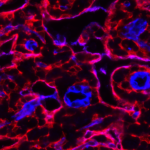Présentation
In the human colon, mucus protects the underlying epithelium from pathogens. During infection, pathogens and resident microbiota compete for nutritional metabolites and therefore changes may alter the equilibrium in the colon ecosystem contributing to the susceptibility to infection. Around 50–60 % of the population in developing countries might be harboring E. histolytica in the outer mucus layer in an asymptomatic manner. Only ∼20% of the cases develop intestinal amoebiasis and thus under conditions not fully understood. E. histolytica overcomes the protective mucus layer using a combination of mucinase/glycosidase and cysteine proteases. Actually, publications of study on the field and in vitro suggest that the outcome of amoebiasis may be influenced by the composition of the gut microbiome.
– In this project, we aim at studying the impact of the mucus colonised with different commensal bacteria (in collaboration with H. Tun) on the mechanic of the epithelium and on E. histolytica behaviour using human organoid-derived colonic epithelial cells (in collaboration with G. Nigro) cultured in an organ-on-a-chip microfluidic device (in collaboration with the microfluidics plateform. S. Gobaa and H. Mary).
– By live imaging and quantitative image we will measure the stress maps within the tissue using an integrated framework to analyze cell mechanics and we will qualify E. histolytica behavior.






